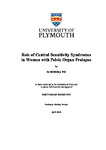Role of Central Sensitivity Syndromes in women with pelvic organ prolapse
| dc.contributor.supervisor | Freeman, Robert | |
| dc.contributor.author | Vij, Monika | |
| dc.contributor.other | Faculty of Health | en_US |
| dc.date.accessioned | 2020-07-14T11:05:58Z | |
| dc.date.available | 2020-07-14T11:05:58Z | |
| dc.date.issued | 2020 | |
| dc.identifier | 10512015 | en_US |
| dc.identifier.uri | http://hdl.handle.net/10026.1/16019 | |
| dc.description.abstract |
Title- Role of Central Sensitivity Syndromes in Women with Pelvic Organ Prolapse. Author- Monika Vij Pelvic Organ Prolapse (POP) is a dysfunction of pelvic floor support and have an ad-verse effect on the quality of life (QOL). The predominant symptom is the feeling of a vaginal bulge. However, a considerable proportion of women report a sensation of dragging, or pelvic pressure vaginally without a bulge or large objective prolapse being present. A mechanism suggested to explain this anomaly describes the augmentation of pain transmission secondary to central sensitization (CS). This explanation is like the pathophysiological changes postulated for central sensitivity syndromes (CSS) (a term collectively used for a group of pain disorders like fibromyalgia, chronic fatigue syn-drome, temporomandibular disorder, chronic pelvic pain, and interstitial cystitis). The purpose of this thesis is to determine whether patients with central sensitivity syn-dromes have different outcomes from the surgical treatment of prolapse, compared to those without CSS. The survey explored the level of awareness about CSS amongst healthcare profession-als managing pelvic organ prolapse and identified that there is gap in knowledge about CSS in this specific group. The second part explored the proportion of women with central sensitivity syndrome attending the gynaecology outpatient clinic and revealed that around 32% of women with pelvic organ prolapse, and 40% with other gynaeco-logical problems had evidence of CSS. The third part of the thesis reviewed the litera-ture around the impact of CSS on post-surgical outcomes. This demonstrated that there is limited evidence currently available on the role of CSS on surgical outcomes. The fourth part of the thesis compared the outcomes of pelvic organ prolapse surgery be-tween the two groups (i.e. those with and without CSS) and found that women with CSS had a lower level of satisfaction and impression of improvement with persistence of symptoms compared to women without CSS. The qualitative study explored wom-en’s views on reasons for poor outcome from surgery amongst women with CSS. Poor surgical technique and /or underlying unidentified bowel or bladder pathology was the perceived reason for poor outcome, rather than CSS. The above findings suggest that there is suboptimal awareness about this condition, amongst healthcare professionals and patients. The findings of the study also suggest that the presence of underlying CSSs could be one of the contributing factors responsible for poor outcomes. These findings will enable clinicians to adequately counsel women with CSS for the possible outcomes of the surgery, while also enabling those patients to have more realistic expectations from the surgery. | en_US |
| dc.language.iso | en | |
| dc.publisher | University of Plymouth | |
| dc.rights | Attribution-NonCommercial-NoDerivs 3.0 United States | * |
| dc.rights.uri | http://creativecommons.org/licenses/by-nc-nd/3.0/us/ | * |
| dc.subject | Central Sensitivity Syndrome | en_US |
| dc.subject | Pelvic Organ Prolapse | en_US |
| dc.subject | Surgical Outcome | en_US |
| dc.subject | Central Sensitisation | en_US |
| dc.subject | Awareness | en_US |
| dc.subject | Survey | en_US |
| dc.subject | Central Sensitisation Inventory | en_US |
| dc.subject.classification | Other (e.g., MD, EdD, DBA, DClinPsy) | en_US |
| dc.title | Role of Central Sensitivity Syndromes in women with pelvic organ prolapse | en_US |
| dc.type | Thesis | |
| plymouth.version | publishable | en_US |
| dc.identifier.doi | http://dx.doi.org/10.24382/805 | |
| dc.rights.embargoperiod | No embargo | en_US |
| dc.type.qualification | Doctorate | en_US |
| rioxxterms.version | NA |
Files in this item
This item appears in the following Collection(s)
-
01 Research Theses Main Collection
Research Theses Main



